Cooking Perfect Rice Made Simple
Cooking perfect rice can sometimes feel like a challenge—whether it turns out too sticky, too dry, or simply not fluffy enough. But with this Simple Rice Hack, you’ll discover a foolproof method that makes cooking rice effortless and stress-free. No more guesswork, no more complicated techniques. Just perfectly cooked rice every time.
Transform Your Rice with Minimal Effort
This simple rice hack is designed to transform your cooking process, ensuring light and fluffy rice without the need for fancy equipment or advanced skills. By following a few easy steps, you’ll achieve consistent, delicious results each time you cook rice.
Master the Basics Before Diving Into Exotic Rice
Once you’ve mastered this simple method, you’ll be well-equipped to tackle a variety of rice types, including exotic rice varieties like basmati, jasmine, wild rice, and more. These varieties may require slightly different techniques and water ratios, but with the basics covered, you’ll be able to handle them with ease. Stay tuned for our Exotic Rice Hack guide to explore how you can elevate your rice game even further.
Expert Tips for Perfect Rice Every Time
In this post, we’ll walk you through each step of the simple rice hack, providing expert tips to make the process easy and efficient. Say goodbye to inconsistent rice and hello to perfectly cooked grains that pair beautifully with any dish!
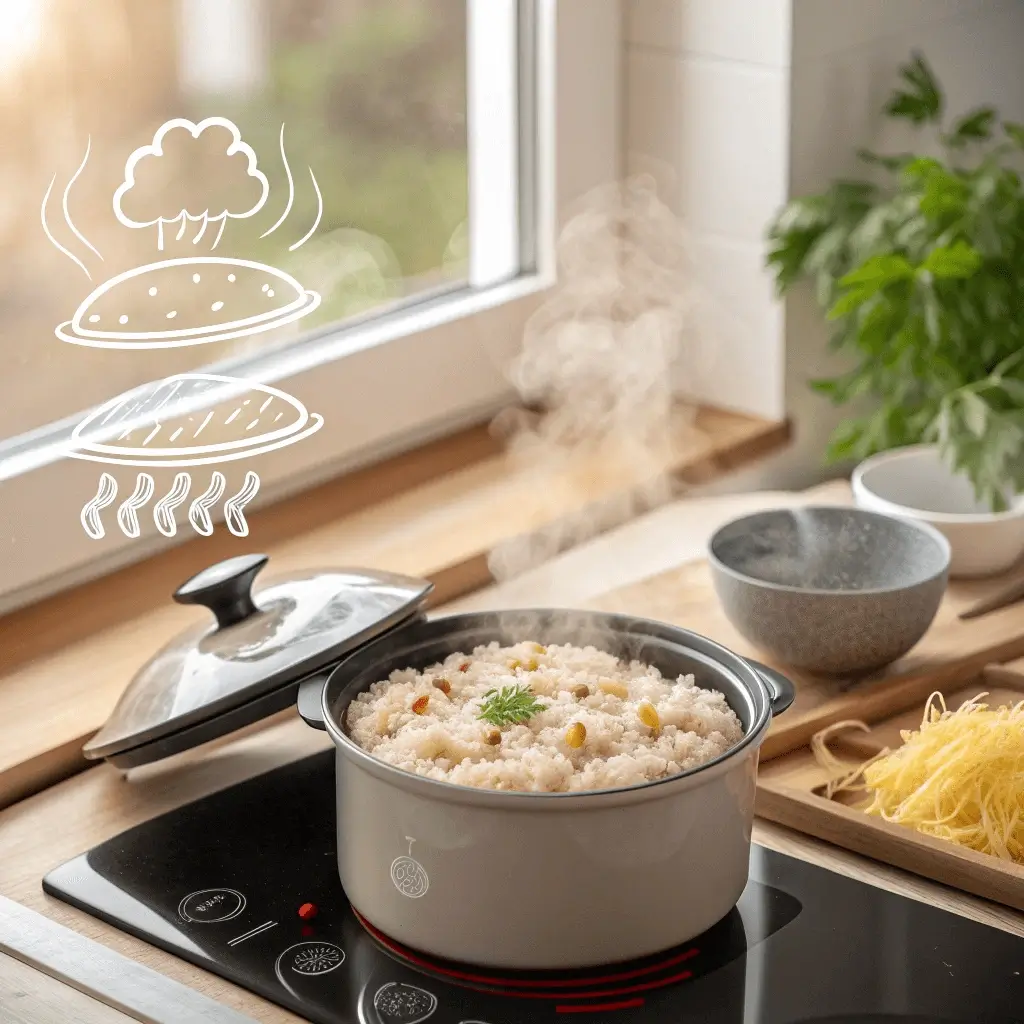
Why This Simple Rice Hack Works
The Science Behind the Hack
Cooking perfect rice involves more than just following a recipe—it’s all about understanding the science behind the process. Here are the key factors that make this simple rice hack so effective:
1. Water-to-Rice Ratio
The right amount of water is crucial for perfect rice. Too much water can make the rice soggy, while too little can leave it undercooked. The hack ensures you use the perfect ratio, allowing the rice to absorb just enough water to cook properly without becoming too wet or too dry.
2. Heat Control & Steaming
After bringing the rice to a boil, the key is to reduce the heat and let the rice simmer. Once it’s done cooking, don’t lift the lid! The trapped steam continues to cook the rice even after the heat is off. This resting time is essential for allowing the rice to become fluffy, as it lets the grains firm up and separate.
3. Rice Type Matters
Different types of rice absorb water in different ways. Long-grain rice like basmati or jasmine tends to stay fluffy and separate easily, while short-grain or sticky rice needs a bit more water and care. The beauty of this hack is that it can be adjusted to work with any type of rice, making it versatile for a variety of dishes.
No More Soggy Rice
One of the most common issues when cooking rice is ending up with soggy, mushy grains. This problem occurs when the rice absorbs too much water or cooks for too long, causing the grains to break down and become overly soft. Fortunately, with this simple rice hack, you can say goodbye to soggy rice for good. Here’s how the hack addresses this issue:
1. Perfect Water-to-Rice Ratio
The key to avoiding soggy rice lies in using the correct water-to-rice ratio. Using too much water leads to the rice soaking up more than it can handle, resulting in a mushy texture. With the hack, we ensure you measure the rice and water precisely. This guarantees that the rice absorbs just the right amount of water—enough for cooking but not too much to make it soggy.
2. Simmering at the Right Heat
The heat level at which you cook the rice plays a huge role in whether it becomes soggy. When the heat is too high, the water evaporates too quickly, causing uneven cooking. On the other hand, cooking at too low of a heat can cause the rice to absorb more water than needed, making it mushy. This hack recommends cooking the rice on low heat, allowing it to simmer gently and absorb the water slowly and evenly for perfect, non-soggy grains.
3. Letting the Rice Rest
After the rice has finished cooking, the hack suggests letting it rest with the lid on for about 10 minutes. This allows the rice to finish cooking in its own steam, which helps remove excess moisture and firms up the grains. The resting time ensures the rice stays fluffy, as it gives the moisture a chance to redistribute evenly without making the rice soggy.
4. Choosing the Right Pot
The pot you use also plays a role in preventing soggy rice. A heavy-bottomed pot with a tight-fitting lid helps maintain the right temperature and keeps the steam trapped inside. This results in even cooking and prevents moisture from escaping, which can cause the rice to cook unevenly and become soggy.
Saves Time and Effort
Cooking rice can sometimes feel like a time-consuming task, especially when you’re trying to get it just right. Between measuring, monitoring, and checking for doneness, it often feels like a lot of extra work. The beauty of this simple rice hack is that it’s designed to save both time and effort, making rice cooking quicker and more convenient without sacrificing quality. Here’s how:
1. Fewer Steps, Less Monitoring
One of the biggest time-savers of this rice hack is the reduction of unnecessary steps. Unlike traditional methods that require frequent stirring, checking, or adjusting the heat, this method keeps it simple. Once you’ve measured the rice and water, and brought it to a boil, you can reduce the heat and leave it alone. There’s no need to hover over the stove or make constant adjustments, allowing you to focus on other tasks while the rice cooks.
2. No Special Equipment Needed
You don’t need a rice cooker or fancy gadgets to make perfect rice with this hack. A basic pot with a lid and a stovetop are all you need. This eliminates the need for additional equipment or waiting for a rice cooker to finish its cycle, saving both time and counter space in the kitchen.
3. Quick Cleanup
Since the method involves fewer steps and less stirring, the cleanup is a breeze. There’s no need to scrape off sticky rice from the sides of the pot or deal with rice splatters. The simplicity of the hack means fewer dishes to wash, so you can spend less time cleaning and more time enjoying your meal.
4. Consistent Results in Less Time
While traditional methods might require you to check the rice periodically to ensure it’s not overcooked or undercooked, this hack ensures you get consistent results in less time. With the right water-to-rice ratio and the perfect heat setting, the rice cooks evenly every time, which means you don’t have to constantly check it. This method guarantees a great outcome with minimal effort, saving you both time and energy in the kitchen.
How to Make Rice in a Rice Cooker: Step-by-Step Guide (Discover the right water ratio, settings, and tips for fluffy rice!)
The Best Type of Rice for This simple Rice Hack
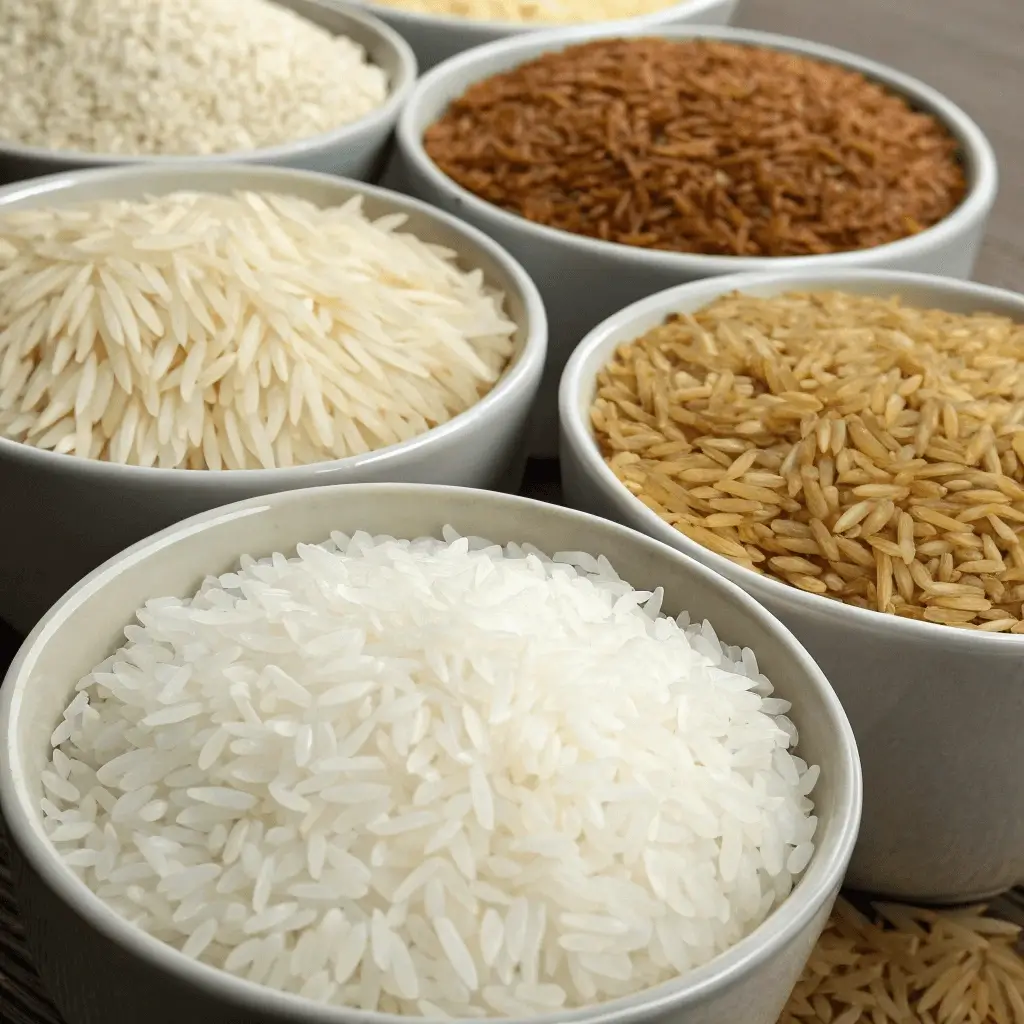
White Rice
White rice is one of the most common types of rice used in everyday cooking, and for good reason. It’s versatile, easy to cook, and pairs well with a variety of dishes. However, many people struggle to get the right texture when cooking white rice. Whether it’s too sticky, too dry, or undercooked, achieving the perfect fluffy white rice can seem elusive. Luckily, with this simple rice hack, cooking white rice becomes effortless. Here’s how the hack works specifically for white rice:
1. Ideal Water-to-Rice Ratio
For white rice, getting the water-to-rice ratio just right is essential for achieving the fluffy texture everyone desires. White rice typically requires a 2:1 water-to-rice ratio (two cups of water for every cup of rice). This hack ensures you use the correct amount of water, preventing your rice from becoming too dry or too soggy. By using the right ratio, the rice absorbs the water evenly, resulting in tender and separate grains without clumping together.
2. Quick Cooking Time
One of the reasons white rice is so popular is its relatively quick cooking time. It generally takes around 15-20 minutes to cook, making it an excellent choice for busy weeknights. With the simple rice hack, you don’t have to worry about constant monitoring or adjustments—just follow the instructions, set your timer, and let the rice cook at a low simmer. The hack helps maintain the right cooking time, ensuring your white rice is done quickly and perfectly every time.
3. No Stirring Needed
When cooking white rice traditionally, you might be tempted to stir it to ensure even cooking. However, stirring too much can release excess starch, leading to sticky rice. This hack eliminates the need for stirring altogether. By letting the rice simmer undisturbed and resting after cooking, you get perfectly fluffy rice without the hassle of constant attention or stirring.
4. Fluffy Texture Every Time
With this hack, you’ll always end up with fluffy white rice that’s not too dry or too wet. By allowing the rice to rest for about 10 minutes after cooking, the steam works to separate the grains and allow any remaining moisture to evenly distribute. This simple step ensures that the rice remains light and fluffy rather than clumpy or sticky, giving you the ideal texture.
Basmati and Jasmine Rice
Basmati and jasmine rice are both fragrant, long-grain varieties that are favored for their distinct aromas and delicate textures. While they share some similarities, cooking them to perfection can be a bit tricky, especially when it comes to getting the ideal fluffy texture. Fortunately, with this simple rice hack, both basmati and jasmine rice can be cooked easily and consistently every time. Here’s how the hack works for these aromatic rice varieties:
1. Perfect Water-to-Rice Ratio for Aroma
Basmati and jasmine rice each require slightly different water ratios to get the best results. For basmati rice, a 1.5:1 water-to-rice ratio (1.5 cups of water for every cup of rice) works best to keep the grains separate and fluffy. For jasmine rice, a 1.75:1 ratio (1.75 cups of water for every cup of rice) provides the right amount of moisture for a tender, non-sticky texture. This simple hack ensures that you use the right amount of water for each type of rice, preventing both undercooking and sogginess.
2. Rinsing for the Best Results
One of the key steps to achieving the perfect texture with basmati and jasmine rice is rinsing it before cooking. Rinsing removes excess starch, which helps prevent the rice from becoming sticky or clumpy. The hack emphasizes the importance of rinsing the rice thoroughly, ideally until the water runs clear. This ensures the rice is free from excess starch and can cook evenly, leading to fluffy, separate grains.
3. Cooking with Low Heat for Fluffy Grains
Both basmati and jasmine rice are delicate, and cooking them at too high a heat can cause them to break or stick together. The hack advises cooking these types of rice on low heat to allow them to absorb the water slowly and evenly. The gentle simmer ensures that the grains cook uniformly, while also helping to preserve their fragrant aromas. This method produces perfectly cooked rice without the need for constant monitoring or stirring.
4. Resting for Perfect Texture
Just like white rice, basmati and jasmine rice benefit from a resting period after cooking. Once the rice has absorbed all the water and the cooking time is complete, the hack recommends letting the rice sit with the lid on for about 10 minutes. This resting time allows the rice to firm up and allows any excess moisture to distribute evenly. When you open the lid after resting, the rice should be fluffy and fragrant, with perfectly separated grains.
Brown Rice Consideration
Brown rice is a healthy, whole-grain alternative to white rice, packed with fiber and nutrients. However, cooking brown rice can be a bit more challenging due to its thicker outer bran layer, which requires more water and a longer cooking time. While it may seem like a more complicated grain to cook, this simple rice hack works just as well for brown rice, ensuring you get perfect results with minimal effort. Here’s how the hack works for brown rice:
1. Increased Water-to-Rice Ratio
Unlike white rice, brown rice needs more water to properly cook due to its bran layer. The recommended water-to-rice ratio for brown rice is generally 2.5:1 (2.5 cups of water for every cup of rice). The hack ensures that you use the right amount of water, which helps soften the rice while keeping it fluffy rather than mushy. The extra water is necessary to penetrate the bran layer and cook the rice evenly.
2. Longer Cooking Time
Because of its thicker outer layer, brown rice takes longer to cook than white rice or aromatic varieties like basmati or jasmine. Typically, brown rice requires about 40-45 minutes of cooking time. The hack simplifies this process by ensuring you cook the rice at a low simmer without the need for constant monitoring. Once the rice has absorbed the water, the resting period (without lifting the lid) allows it to finish cooking in its own steam, giving you perfectly tender rice every time.
3. Soaking Brown Rice (Optional but Helpful)
While this is an optional step, soaking brown rice for 30 minutes to an hour before cooking can help reduce the cooking time slightly and allow the water to penetrate the grain more evenly. This hack can also be helpful if you’re cooking brown rice for a recipe that needs a quicker turnaround. If you choose to soak it, be sure to adjust the cooking time and water accordingly, as soaked rice will require less water to cook than unsoaked rice.
4. Resting for Fluffiness
After cooking, it’s just as important to let brown rice rest as it is for white rice. Once the rice has absorbed all the water and the cooking is complete, let it sit for about 10 minutes with the lid on. This resting time helps the rice firm up and prevents it from being overly wet or sticky. The moisture redistributes evenly, giving you light and fluffy brown rice without the heaviness that sometimes accompanies it.
Step-by-Step Guide to Making Perfect Rice Every Time
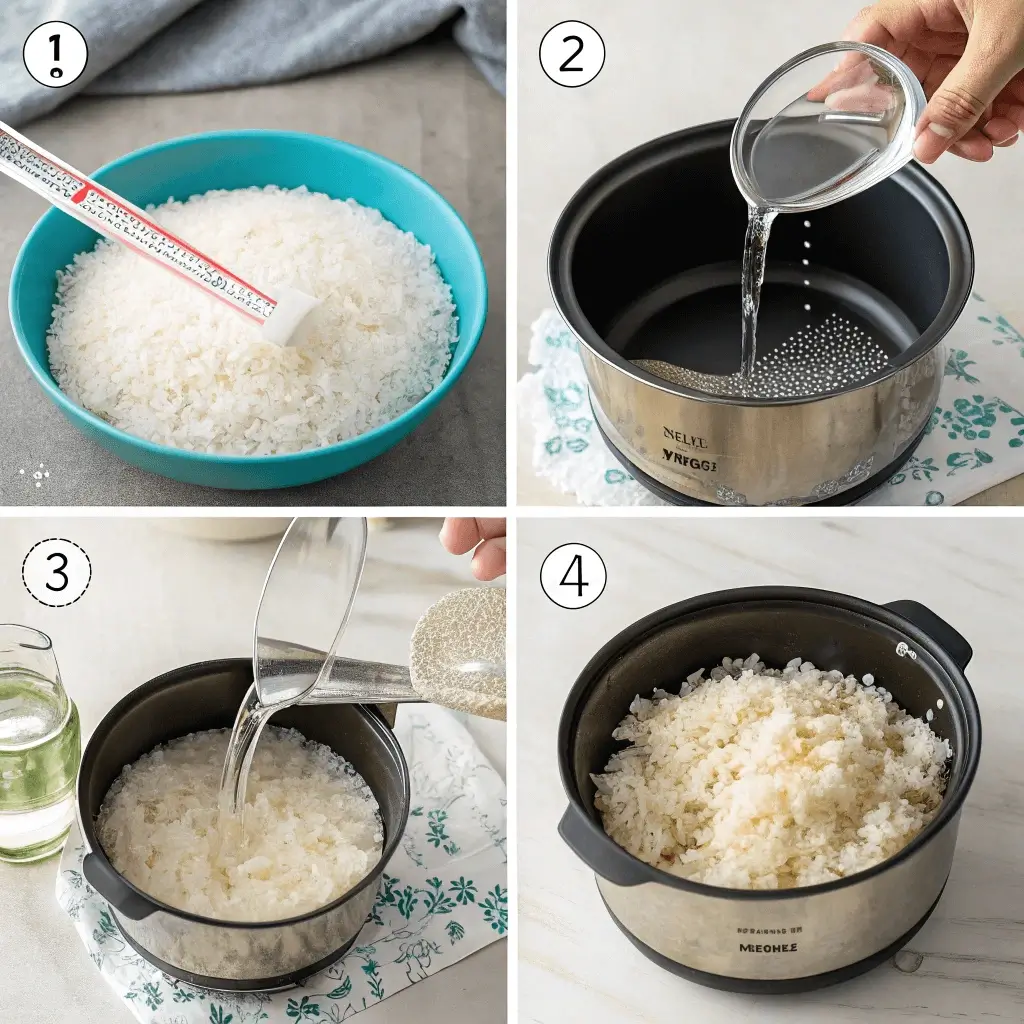
Gather Ingredients and Equipment for this simple rice hack
Before you start cooking rice, it’s important to have all your ingredients and equipment ready. Having everything prepared will ensure the process goes smoothly and efficiently, allowing you to focus on getting that perfect rice. With this Simple Rice Hack Recipe, you’ll be able to achieve flawless rice without any hassle. Here’s a breakdown of what you’ll need:
1. Ingredients
The ingredients for cooking rice are simple, but using the right amounts is key to success. Here’s what you’ll need:
- Rice: Choose the type of rice you want to cook—whether it’s white, basmati, jasmine, or brown rice. Be sure to measure the rice properly, as the water-to-rice ratio depends on the type.
- Water: The amount of water will depend on the type of rice you’re using. For white rice, you’ll generally need twice the amount of water as rice, while brown rice will need more water, typically 2.5 cups of water per cup of rice.
- Salt (Optional): A pinch of salt can be added to enhance the flavor of the rice, but it’s optional depending on your taste preference.
- Butter or Oil (Optional): For added flavor and richness, a small amount of butter or oil can be added before cooking. This is particularly useful for dishes where you want the rice to have a bit more depth or to prevent it from sticking.
2. Equipment
Having the right equipment is crucial for making rice the easy way. Here’s what you’ll need to ensure the cooking process is as smooth as possible:
- Pot with a Tight-Fitting Lid: A pot with a heavy bottom and a well-fitting lid is essential. The lid helps trap steam, which is key to cooking the rice evenly and preventing moisture from escaping. It’s important that the lid is tight to keep the steam inside during the simmering and resting phases.
- Measuring Cups: Accurate measurements are key to getting the water-to-rice ratio just right. A standard measuring cup for both rice and water will ensure you’re using the proper proportions for your rice type.
- Stove: You’ll need a stove to bring the rice and water to a boil and then lower the heat to a simmer. This simple hack works best when you cook the rice over low heat to allow the rice to absorb the water gradually.
- Timer: Using a timer is important to track the cooking time and ensure that the rice doesn’t overcook. The resting period after cooking also requires a timer to make sure you leave the rice covered for the right amount of time (usually around 10 minutes).
3. Optional Extras
While not strictly necessary for the rice hack, these extras can enhance your cooking experience:
- Rice Rinsing Bowl or Sieve: If you’re using basmati, jasmine, or other types of rice that benefit from rinsing, a fine-mesh sieve or small bowl is helpful for washing away excess starch. Rinsing helps prevent the rice from becoming sticky and ensures a fluffy texture.
- Serving Dish: Once your rice is perfectly cooked, a serving dish or bowl will be useful to present the rice when ready to eat.
Measure and Rinse the Rice
Measuring and rinsing the rice are two simple yet essential steps that help ensure the best possible results. By getting the right amount of rice and water, and by rinsing it to remove excess starch, you’ll set yourself up for perfectly fluffy rice every time. Here’s how this Simple Rice Hack Recipe works for you:
1. Measure the Rice
The first step is to measure the rice accurately. Using a standard measuring cup, take the amount of rice you plan to cook. It’s important to be precise with the measurements because the water-to-rice ratio is key to achieving the perfect texture. Typically, for white rice, use a 1:2 ratio (1 cup of rice to 2 cups of water), while for brown rice, a 1:2.5 ratio (1 cup of rice to 2.5 cups of water) is recommended. This hack works best when you get the proportions right, so make sure to measure carefully.
For larger quantities, simply adjust the ratio—if you want to cook 2 cups of rice, use 4 cups of water for white rice or 5 cups for brown rice.
2. Rinse the Rice (Optional for White Rice)
Rinsing rice is an important step, especially for varieties like basmati, jasmine, and brown rice. Rinsing removes the excess starch that can cause the rice to become sticky or clump together during cooking. By washing the rice, you help the grains stay separate and achieve that light, fluffy texture.
- How to Rinse: Place the measured rice in a fine-mesh sieve or bowl and rinse under cold water. Gently swirl the rice with your hand to ensure that all the grains are washed. Continue rinsing until the water runs clear, indicating that most of the starch has been removed.
For white rice, rinsing is optional but can improve texture, especially for varieties like basmati. For brown rice, rinsing is also recommended to remove dust and debris, although it’s not as critical for preventing stickiness due to its lower starch content.
3. Drain the Rice (After Rinsing)
After rinsing, it’s important to drain the rice thoroughly. Allow the rice to sit in the sieve for a minute or two to ensure that any excess water has drained away. This helps prevent the rice from becoming soggy during cooking. If you’re using a bowl, gently tilt the bowl to pour out any excess water.
Apply the Hack
Now that you’ve gathered your ingredients, measured, and rinsed your rice, it’s time to apply the Simple Rice Hack Recipe. This is where the magic happens. By following this straightforward method, you’ll ensure perfectly cooked rice every time, with minimal effort. Here’s how to apply this Simple Rice Hack Recipe effectively:
1. Combine Rice and Water in the Pot
Start by placing your measured, rinsed rice into a pot with a tight-fitting lid. Then, add the appropriate amount of water based on the type of rice you’re cooking. For white rice, the water-to-rice ratio is typically 2:1 (2 cups of water for every 1 cup of rice), while brown rice will need more water—around 2.5 cups of water per 1 cup of rice.
Ensure the rice and water are evenly distributed in the pot. You can give it a quick stir to help combine the rice and water, but avoid stirring too much, as this can release extra starch, which can affect the texture of the rice.
2. Bring to a Boil
Place the pot on the stove and turn the heat to high to bring the water to a boil. This step is important because it helps the rice begin to cook quickly and evenly. As soon as the water reaches a boil, you’ll want to reduce the heat right away to maintain a gentle simmer, which is key to getting perfect rice.
3. Reduce Heat and Simmer
Once the water has boiled, immediately lower the heat to the lowest setting. Cover the pot with the tight-fitting lid, making sure it’s sealed well to trap the steam inside. Let the rice simmer on low heat for the appropriate time based on the type of rice:
- White Rice: Simmer for 15-20 minutes until all the water has been absorbed and the rice is tender.
- Brown Rice: Simmer for 40-45 minutes to allow the rice to fully cook and soften.
The key is to resist the urge to open the lid during this cooking phase. The steam inside the pot helps cook the rice evenly and prevents it from drying out.
4. Let It Rest
After your rice has absorbed all the water and the cooking time is complete, resist the temptation to immediately lift the lid! Allow the rice to rest, covered, for about 10 minutes. This crucial step allows the grains to firm up and ensures that any remaining moisture is evenly distributed throughout.
Why Resting Is Essential
Resting the rice is key to achieving that perfect, fluffy texture. This process prevents the rice from becoming soggy and helps each grain maintain its distinct shape. By following this step, you’ll notice a significant difference in the final result—light, airy, and evenly cooked rice, every time.
A Foundation for Cooking Exotic Rice
Once you’ve mastered the resting technique for simple rice, you’ll find it equally effective when cooking exotic rice varieties like basmati or jasmine. These types of rice may have slightly different cooking needs, but resting the rice at the end will always help you achieve that sought-after fluffy texture. Stay tuned for more Exotic Rice Hacks to perfect your skills even further.
Let It Rest for Perfect Texture with the Simple Rice Hack
The “let it rest” step is crucial to achieving the perfect rice texture, and it’s often overlooked. After the rice has finished cooking and absorbed all the water, it’s essential to give it a rest before serving. This simple yet effective step ensures that the rice is fluffy, well-cooked, and evenly moist. Here’s why and how you should let your rice rest:
1. Why Resting is Important
Resting allows the rice to finish cooking in its own steam, which helps to firm up the grains and redistribute the moisture. When rice is cooked, it absorbs water and swells, but some grains may still contain extra moisture. By allowing the rice to rest, the residual heat and steam from the pot help evenly distribute this moisture, ensuring that each grain is perfectly cooked and not too wet or sticky, all thanks to the Simple Rice Hack Recipe.
Additionally, resting helps the rice firm up and become less fragile. This is especially important for rice varieties like basmati, jasmine, and brown rice, which benefit from a little time to settle and firm up after the cooking process, using the Simple Rice Hack Recipe for optimal results.
2. How Long Should You Let It Rest?
For optimal results, let the rice rest for about 10 minutes after cooking. During this time, keep the lid on the pot to trap the steam inside. Avoid lifting the lid too soon, as this can release valuable steam and disrupt the resting process. The 10-minute rest period allows the rice to fully absorb any remaining moisture, ensuring that the grains are fluffy and separate when you fluff them with a fork.
3. Fluff the Rice Before Serving
Once the 10 minutes are up, use a fork to gently fluff the rice. This step, part of the Simple Rice Hack Recipe, helps separate the grains and release trapped steam. This ensures that the rice stays light and airy. Be gentle when fluffing to avoid breaking the grains. The fluffing process is crucial. It not only makes the rice easier to serve but also enhances its texture. This makes the rice more inviting and appetizing.
4. Additional Tips for Resting Rice
- Don’t Skip This Step: While it may seem tempting to serve the rice immediately after the cooking time is over, skipping the resting step can lead to overly moist or sticky rice.
- Keep It Covered: Always keep the lid on the pot while the rice rests. The trapped steam continues to work its magic on the rice, ensuring it stays warm and fluffy until you’re ready to serve.
- Resting for Different Rice Types: While most rice varieties benefit from a resting period, the amount of time may vary slightly. For instance, brown rice may require an additional 5 minutes of resting due to its denser texture.
Simple Rice Hack: Best Tips & Resources for Perfect Rice
For additional insights and expert advice on mastering rice cooking, check out this helpful guide:
🔗 Simple Rice Hack: Mastering the Perfect Rice Texture Every Time (Learn the science behind cooking rice to perfection!)
Common Rice-Cooking Mistakes to Avoid
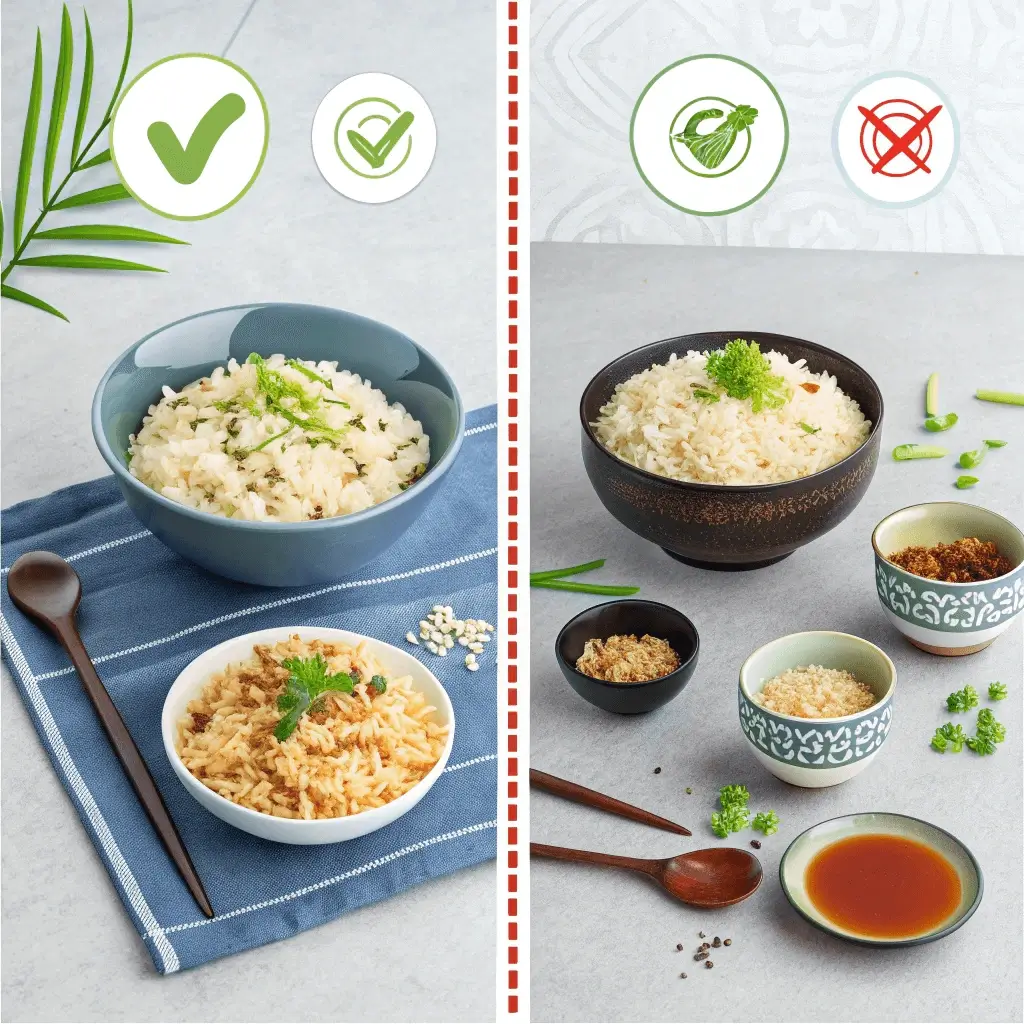
Cooking rice may seem simple, but it’s easy to make a few mistakes that can lead to less-than-ideal results. Whether it’s overcooking, using the wrong amount of water, or stirring too much, each of these mistakes can affect the texture and flavor of your rice. Here’s a breakdown of common cooking errors and how to avoid them:
Overcooking Rice
Simple Rice Hack: Different Rice-to-Water Ratios for Perfect Texture
🔗 https://www.thekitchn.com/how-to-cook-rice-226756
Overcooking rice is a common mistake, especially for beginners. When rice is left to cook for too long, it can become mushy, sticky, or even burnt at the bottom. This happens because the grains absorb too much water and lose their firm texture.
- How to Avoid It: To prevent overcooking, always follow the recommended cooking times for each type of rice. Once the rice is done cooking (i.e., all the water has been absorbed), remove the pot from the heat immediately. Also, resist the temptation to keep it on the heat for “just a few more minutes.” Remember, rice continues to cook during the resting period after the heat is turned off, so you don’t need to extend the cooking time unnecessarily. Let it rest for about 10 minutes before fluffing and serving.
Using Too Much or Too Little Water
The right water-to-rice ratio is essential in this Simple Rice Hack Recipe for getting perfect rice. Using too much water can lead to soggy, wet rice, while too little water can result in undercooked, hard rice. Both mistakes can ruin the texture of your dish and make it unappetizing. By following this Simple Rice Hack Recipe, you’ll ensure the ideal ratio every time for consistently perfect rice.
- How to Avoid It: Always measure your rice and water accurately before cooking. Different types of rice require different water ratios, so make sure you’re using the correct ratio for the rice variety you’re cooking. For example, white rice generally needs a 2:1 water-to-rice ratio, while brown rice needs a 2.5:1 ratio. If you’re cooking aromatic rice like basmati or jasmine, make sure to follow the specific water ratio for each type. If in doubt, check the package instructions for guidance.
- Tip: If you’re unsure about the water level, it’s better to use a little extra water rather than too little, as you can always drain excess water if necessary. However, once rice is overcooked with too much water, it’s difficult to salvage.
Stirring Too Much
Stirring rice while it cooks might seem like a good idea to make sure the grains are evenly cooked. However, stirring too much or too often can release excess starch, resulting in sticky or clumpy rice. For certain rice varieties, this can ruin the fluffy texture you’re aiming for.
- How to Avoid It: Once you’ve added the rice and water to the pot, stir just once to ensure it’s evenly distributed. After that, avoid stirring during the cooking process. Stirring disrupts the rice’s cooking process and can cause the grains to break apart. Let the rice cook undisturbed on low heat until the water has been absorbed. If you’re worried about the rice sticking to the pot, you can lightly oil the pot or use a non-stick pot to minimize this issue.
- Tip: After the rice has finished cooking, you can gently fluff it with a fork to separate the grains. But avoid using a spoon to stir, as this could break the rice and make it mushy.
Other Mistakes to Keep in Mind
- Not Letting Rice Rest: As mentioned earlier, not allowing the rice to rest for 10 minutes after cooking can lead to overly moist or sticky rice. Resting allows the moisture to evenly distribute and prevents sogginess.
- Opening the Lid Too Early: Lifting the lid during cooking releases valuable steam and heat, which can affect the cooking process. It’s best to keep the lid on until the cooking time is complete, only opening it once the rice has rested.
Quick Tips for Fluffy Rice in Less Than 20 Minutes
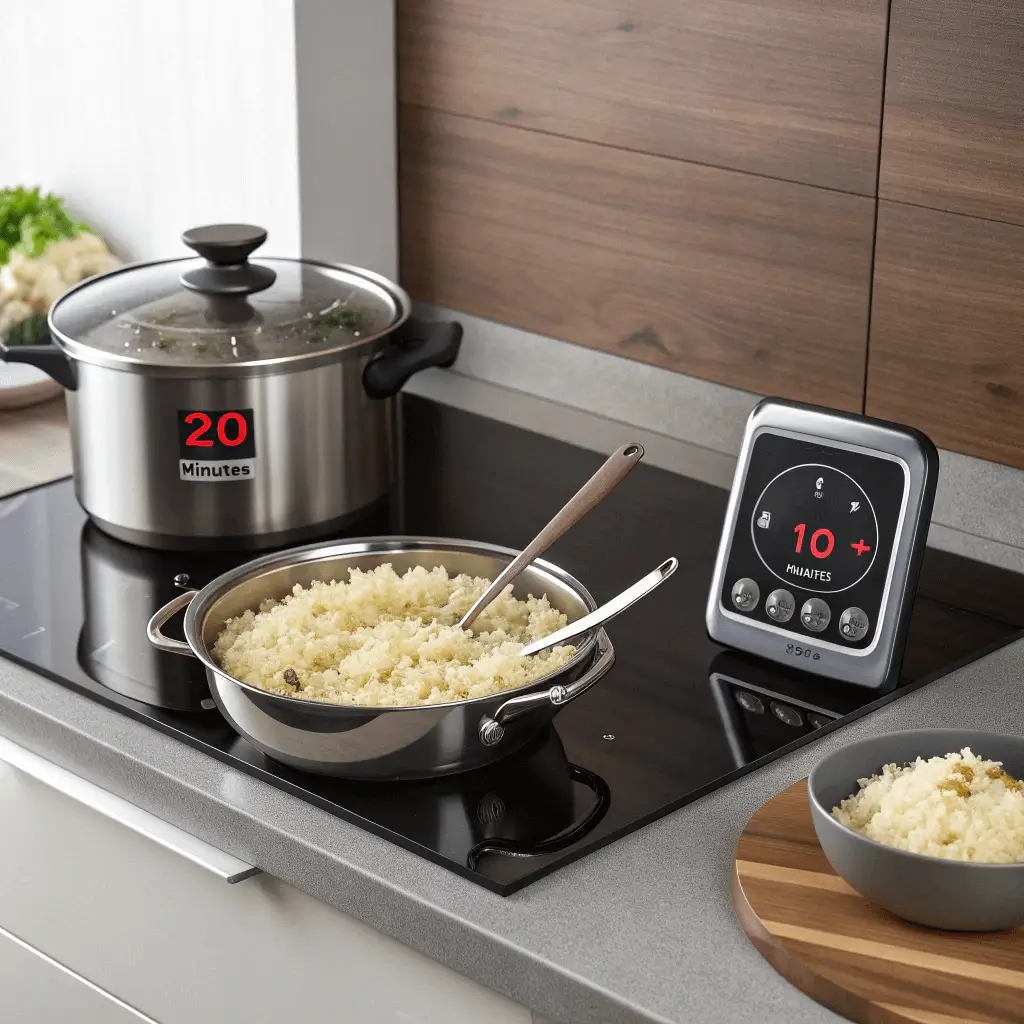
Cooking perfect rice in a short amount of time is possible with a few simple tricks. These tips will help you achieve fluffy, tender rice in under 20 minutes—perfect for a quick meal or when you’re short on time. Here’s how to get the best results with minimal effort:
Use a Pot with a Tight-Fitting Lid
One of the most important factors in cooking rice is the pot you use. A pot with a tight-fitting lid is essential for trapping steam, which helps cook the rice evenly and prevents it from drying out or becoming too soggy.
- How it Works: When you cook rice, water turns into steam and needs to remain in the pot to properly cook the rice. If your lid doesn’t fit well, steam escapes, and the rice might not cook evenly or fully. A tight lid ensures that the steam is trapped inside, circulating around the rice and cooking it perfectly without the need for constant attention.
- Tip: A heavy-bottomed pot is also ideal, as it distributes heat evenly and prevents the rice from burning at the bottom while cooking. Whether you use a regular pot or a specialized rice cooker, the key is to make sure the lid seals tightly and keeps the steam contained.
The 10-Minute Steam Time
After your rice has finished cooking, it’s crucial to let it rest for at least 10 minutes with the lid on. This is often one of the most overlooked steps but is absolutely essential for achieving fluffy rice.
- Why It’s Important: During the cooking process, the rice absorbs water and becomes tender. However, there is still residual moisture in the rice that needs time to evenly redistribute. By allowing the rice to rest with the lid on, the steam trapped inside helps the grains firm up and settle into a perfect texture. This step ensures that the rice is light and fluffy rather than too wet or sticky.
- How to Do It: Once the rice has absorbed all the water and the cooking time is complete, remove the pot from the heat but keep the lid tightly closed. Set a timer for 10 minutes to ensure that the rice rests for long enough. During this time, resist the urge to open the lid and check on it—you want to keep all the steam inside.
- Tip: If you’re in a rush, you can reduce the resting time slightly, but the 10-minute mark is ideal for achieving the best texture.
Don’t Lift the Lid During Cooking
It can be tempting to lift the lid to check on your rice, especially when you’re unsure if it’s cooking properly. However, doing this can disrupt the cooking process and prevent the rice from cooking evenly.
- Why It’s Crucial: When you lift the lid, steam escapes, and the temperature inside the pot drops. This can interfere with the cooking time and cause the rice to cook unevenly. Consistency is key, and keeping the lid on helps maintain the correct temperature and moisture level throughout the cooking process.
- How to Avoid It: Trust the process! Once you bring the water to a boil, reduce the heat to low and let the rice cook undisturbed. Most types of rice require a specific cooking time, and opening the lid too soon can result in undercooked rice or soggy rice from excess moisture. Even if you hear bubbling or steam, it’s best to leave the lid alone until the time is up.
- Tip: If you feel like you need to check the rice, gently lift the lid after the cooking time is up and before the resting period. You can take a quick look to see if all the water has been absorbed, but avoid stirring or disturbing the rice.
Conclusion
In this Simple Rice Hack Recipe, we’ve shown you how to cook perfect rice every time with minimal effort. By following a few simple steps—measuring and rinsing the rice, using the correct water-to-rice ratio, applying the steam method, and letting the rice rest—you’ll get rice that is light, fluffy, and delicious.
The benefits of this Simple Rice Hack Recipe are clear. You’ll avoid common mistakes like overcooking, using too much or too little water, and stirring too much. This ensures consistent, reliable results.
We’ve also highlighted the importance of using a pot with a tight-fitting lid, letting the rice rest for 10 minutes, and resisting the urge to lift the lid while the rice cooks. With these tips and your newfound knowledge, you’ll achieve perfectly cooked rice every time—whether you’re preparing a quick dinner or a special meal.
I encourage you to try this Simple Rice Hack Recipe and experiment with different types of rice. Whether it’s white rice, basmati, jasmine, or brown rice, each variety offers its own unique flavor and texture. Mastering this technique will elevate any dish you prepare.
We’d love to hear about your experience with this Simple Rice Hack Recipe! Feel free to share your results or any other rice-cooking tips you’ve discovered. Cooking is all about experimenting and perfecting your technique. Your feedback could inspire others to make their rice even better. Happy cooking!


5 thoughts on “Simple Rice Hack Recipe: How to Make Perfect Rice Every Time”